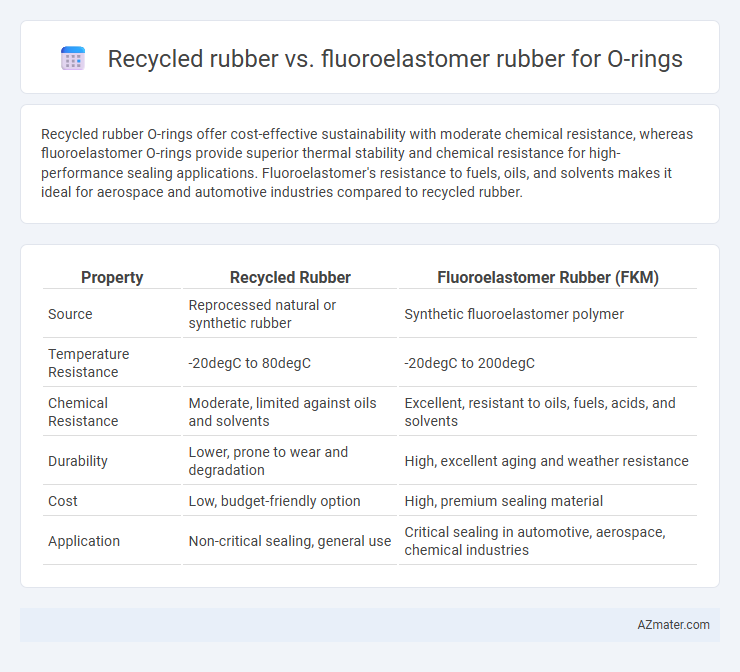Recycled rubber O-rings offer cost-effective sustainability with moderate chemical resistance, whereas fluoroelastomer O-rings provide superior thermal stability and chemical resistance for high-performance sealing applications. Fluoroelastomer's resistance to fuels, oils, and solvents makes it ideal for aerospace and automotive industries compared to recycled rubber.
Table of Comparison
| Property | Recycled Rubber | Fluoroelastomer Rubber (FKM) |
|---|---|---|
| Source | Reprocessed natural or synthetic rubber | Synthetic fluoroelastomer polymer |
| Temperature Resistance | -20degC to 80degC | -20degC to 200degC |
| Chemical Resistance | Moderate, limited against oils and solvents | Excellent, resistant to oils, fuels, acids, and solvents |
| Durability | Lower, prone to wear and degradation | High, excellent aging and weather resistance |
| Cost | Low, budget-friendly option | High, premium sealing material |
| Application | Non-critical sealing, general use | Critical sealing in automotive, aerospace, chemical industries |
Introduction to O-Ring Materials: Recycled Rubber vs Fluoroelastomer
Recycled rubber O-rings offer cost-effective sealing solutions with moderate resistance to abrasion, chemicals, and temperature fluctuations, making them suitable for non-critical applications and environmentally conscious projects. Fluoroelastomer O-rings provide superior chemical resistance, high-temperature stability up to 200degC, and excellent durability in aggressive environments, crucial for aerospace, automotive, and chemical processing industries. Selecting between recycled rubber and fluoroelastomer O-rings depends on application-specific requirements such as sealing performance, exposure to chemicals, temperature range, and budget constraints.
Environmental Impact of Recycled Rubber and Fluoroelastomer O-Rings
Recycled rubber O-rings significantly reduce landfill waste and lower the carbon footprint by reusing materials from scrap tires and industrial rubber products, promoting sustainable manufacturing practices. Fluoroelastomer O-rings, while offering exceptional chemical resistance and durability, are derived from non-renewable fluorinated polymers with higher energy-intensive production processes and limited recyclability. Choosing recycled rubber O-rings supports circular economy goals and minimizes environmental impact compared to the petrochemical-based fluoroelastomer alternatives.
Chemical Resistance: Recycled Rubber vs Fluoroelastomer O-Rings
Fluoroelastomer O-rings exhibit superior chemical resistance compared to recycled rubber, effectively withstanding a wide range of aggressive chemicals including oils, fuels, and solvents. Recycled rubber O-rings tend to degrade when exposed to harsh chemicals, limiting their use in demanding industrial applications. The enhanced molecular structure of fluoroelastomers ensures long-lasting durability in corrosive environments, making them a preferred choice for chemical resistance.
Temperature Performance Comparison
Recycled rubber O-rings typically withstand temperatures ranging from -40degC to 70degC, making them suitable for general-purpose sealing applications but limiting their use in extreme thermal environments. Fluoroelastomer (FKM) O-rings offer superior temperature performance with an operational range from -26degC to 204degC, maintaining chemical resistance and elasticity under high heat exposure. For applications requiring high-temperature durability and resistance to aggressive chemicals, fluoroelastomer O-rings provide significantly enhanced reliability compared to recycled rubber options.
Durability and Longevity of O-Ring Materials
Recycled rubber O-rings offer cost-effective solutions with moderate durability, but they often degrade faster under harsh chemical or extreme temperature conditions compared to fluoroelastomer O-rings. Fluoroelastomer O-rings demonstrate superior resistance to heat, chemicals, and ozone, ensuring exceptional longevity and performance in demanding industrial applications. The enhanced molecular stability and flexibility of fluoroelastomer materials result in significantly extended service life, reducing maintenance frequency and downtime.
Cost Analysis: Recycled Rubber vs Fluoroelastomer
Recycled rubber O-rings offer significant cost savings, typically priced 40-60% lower than fluoroelastomer O-rings due to lower raw material and processing expenses. Fluoroelastomer O-rings, such as those made from Viton, incur higher initial costs but provide superior chemical resistance, temperature tolerance up to 200-250degC, and longer service life, potentially reducing overall maintenance expenses. For applications with moderate performance requirements, recycled rubber presents a budget-friendly alternative, while fluoroelastomer remains the cost-effective choice in demanding industrial environments where durability and reliability minimize long-term replacement costs.
Mechanical Properties and Flexibility
Recycled rubber O-rings offer moderate tensile strength and good flexibility, making them suitable for low to medium stress applications, while fluoroelastomer (FKM) O-rings provide superior mechanical properties, including high tensile strength, excellent abrasion resistance, and exceptional flexibility across a wide temperature range. Fluoroelastomer O-rings maintain elasticity and deformation resistance in extreme chemical and thermal environments, outperforming recycled rubber in durability and long-term sealing performance. The enhanced mechanical resilience and flexibility of fluoroelastomer make it the preferred choice for critical applications requiring high chemical resistance and mechanical stability.
Typical Applications of Each O-Ring Material
Recycled rubber O-rings are commonly used in non-critical sealing applications such as garden equipment, general industrial machinery, and temporary seals due to their cost-effectiveness and moderate resistance to abrasion and weathering. Fluoroelastomer (FKM) O-rings excel in high-performance environments including automotive fuel systems, aerospace hydraulic systems, and chemical processing where exceptional resistance to heat, oils, fuels, and aggressive chemicals is essential. The selection between recycled rubber and fluoroelastomer materials depends largely on application-specific requirements for chemical compatibility, temperature range, and durability.
Regulatory and Safety Considerations
Recycled rubber O-rings must comply with stringent environmental regulations such as REACH and RoHS to limit hazardous substances and ensure safe reuse, while fluoroelastomer (FKM) O-rings typically meet higher standards like FDA and ASTM certifications for chemical resistance and non-toxicity in critical applications. Fluoroelastomers offer superior resistance to heat, chemicals, and aging, reducing the risk of leaks and contamination in sensitive environments, which enhances overall system safety. Regulatory agencies often favor fluoroelastomer O-rings in aerospace, medical, and food industry applications due to their proven durability and compliance with strict safety standards.
Choosing the Right O-Ring Material for Your Application
Recycled rubber offers cost-effective and sustainable O-ring solutions with good flexibility and moderate chemical resistance, ideal for non-critical applications with low exposure to harsh chemicals or extreme temperatures. Fluoroelastomer rubber excels in high-performance environments, providing superior resistance to heat up to 200degC, aggressive chemicals, oils, and fuels, making it the preferred choice for aerospace, automotive, and chemical processing industries. Selecting the right O-ring material requires balancing operational conditions, chemical compatibility, temperature range, and budget considerations to ensure optimal sealing performance and longevity.

Infographic: Recycled rubber vs Fluoroelastomer rubber for O-ring
 azmater.com
azmater.com